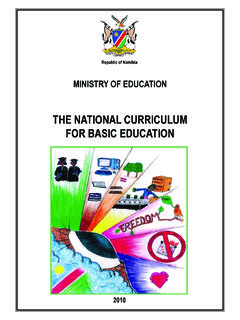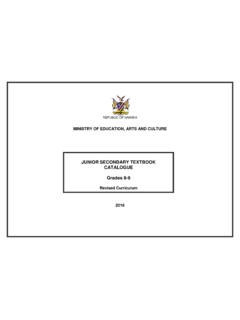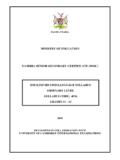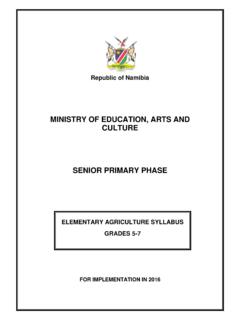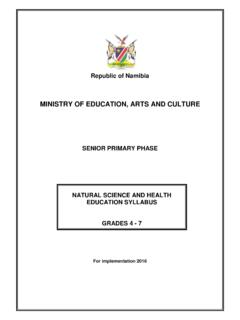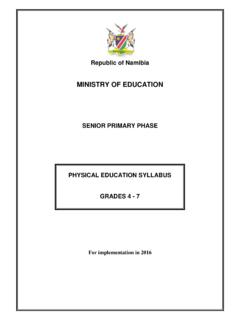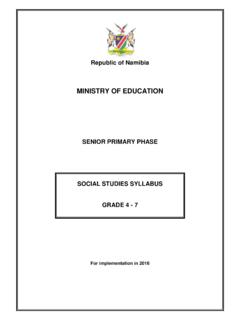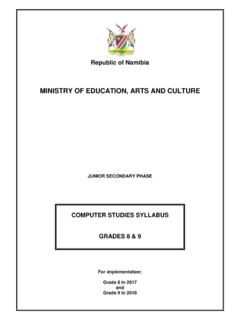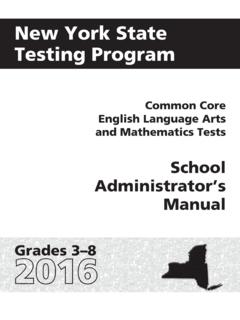Transcription of MINISTRY OF EDUCATION, ARTS AND CULTURE
1 Republic of Namibia MINISTRY OF education , arts AND CULTURE SENIOR PRIMARY PHASE For implementation in 2016 mathematics SYLLABUS GRADES 4 - 7 MINISTRY of education , arts and CULTURE National Institute for Educational Development (NIED) Private Bag 2034 Okahandja Namibia Copyright NIED, MINISTRY of education , arts and CULTURE , 2014 mathematics Syllabus Grades 4 - 7 ISBN: 0-86976-829-8 Printed by NIED Website: Publication date: December 2014 TABLE OF CONTENTS 1. Introduction ..1 2. Rationale ..1 3. Aims ..1 4. Inclusive education ..2 5. Links to Other Subjects and Cross-curricular 6. Approach to Teaching and Learning ..3 7. End of Phase Competencies ..4 8. Summary of the Learning Content ..6 9. Learning Content .. 10 Grade 4 .. 10 Grade 5 .. 21 Grade 6 .. 35 Grade 7 .. 48 10. Assessment .. 58 Types of Assessment.
2 58 Grade Descriptors .. 59 Assessment Objectives .. 60 Continuous Assessment: Detailed Guidelines .. 61 End of year examinations: Detailed guidelines .. 63 Promotion Mark .. 64 Specification Grid(s) .. 66 Assessment Rubrics/Criteria .. 67 Additional Information .. 69 Annex 1: Glossary of Terms Used in mathematics Teaching and Assessment Activities .. 69 Annex 2: Glossary of Terms .. 73 Annex 3: Metric and SI units .. 76 Annex 4: International System prefixes .. 76 Annex 5: Continuous Assessment Harvest Record Sheet .. 77 Annex 6: Assessment Record Sheet for Grade 4 (Term 1 and 2) .. 78 Annex 7: Assessment Record Sheet for Grade 4 (Term 3) .. 79 Annex 8: Assessment Record Sheet for Grade 5 .. 80 Annex 8: Assessment Record Sheet for Grades 6 and 7 .. 81 mathematics Syllabus Grade 4 7, NIED 2014 1 1. Introduction This syllabus describes the intended learning and assessment for mathematics in the Senior Primary level.
3 The mathematics learning area consists of preparatory mathematics (Pre-Primary) and mathematics (Grades 1-12) and has thematic links to other subjects across the curriculum The aims and learning objectives, which overlap between subjects are amongst the essential competencies within the curriculum as a whole. Under optimal circumstances, this subject would need seven (7) periods per week for grade 4 and six (6) periods per week for grades 5, 6 and 7. 2. Rationale mathematics involves observing, representing and investigating patterns and quantitative relationships in social and physical phenomena and between mathematical objects themselves. Through these processes new mathematical ideas and insights are generated. mathematics uses its own specialised language that involves notations and symbols for describing numeric, geometric and graphic relations.
4 Mathematical concepts build on one another throughout all the phases, thereby creating a coherent structure. mathematics is a purposeful activity in the context of social, political, technological and economic goals and constraints. It is a discipline that is not value-free or culturally neutral. Its knowledge is part of CULTURE and we need this knowledge and these skills in order to solve many everyday tasks, and to take care of personal interests and duties. It contributes to the development of logical and scientific thinking and provides pleasure and satisfaction when learners solve problems and enjoy number games. Numeracy is one of the two core features of primary education , the other being literacy. mathematics and the languages are thus the most important subjects in the curriculum in this phase. Therefore, the syllabus extends the basic competencies in computation with whole numbers to computation with common and decimal fractions.
5 Measurement, time, and money and finance relate to the learner s everyday situation. Geometry is the mathematical understanding of space and shapes. The themes of problem solving, number patterns and data handling are ways of working with, understanding and communicating about and through mathematics . Learners will not use calculators, but emphasis is to be placed on mental arithmetic strategies to develop the learners awareness of number and number sense. 3. Aims mathematics education promotes the following aims in the curriculum: to develop functional numeracy and mathematical thinking; to develop positive attitudes towards mathematics ; to enable learners to acquire basic number concepts and numerical notation; to enable learners to understand and master the basic mathematical concepts and skills; to enable learners to apply mathematics in everyday life. to prepare learners for present and future studies in mathematics and other related subjects mathematics Syllabus Grade 4 7, NIED 2014 2 4.
6 Inclusive education The Senior Primary Phase of education promotes equality of opportunity in males and females, enabling both sexes to participate equally and fully. Teachers should know and understand how to treat learners equally, and all materials should support gender equity. Teachers must be aware of the ways in which boys or girls often become favouritised in the classroom interaction, and ensure that their role promotes gender equity. There are stereotype expectations that mathematics and science are more difficult for girls. However, it has been shown that girls will not do as well as boys becomes a self-fulfilling prophecy unless the teacher is aware of the problem. It is also known that the way problems are contextualised and exemplified in mathematics can act as a gender filter. It is essential that the Senior Primary Phase creates motivation and confidence in girls as much as in boys in mathematics .
7 5. Links to Other Subjects and Cross-curricular Issues The cross-curricular issues including Environmental Learning; HIV and AIDS; Population education ; education for Human Rights and Democracy (EHRD), Information and Communication Technology (ICT) and Road Safety have been introduced to the formal curriculum to be dealt with in each subject and across all phases because each of the issues deals with particular risks and challenges in our Namibian society. All of our learners need to: understand the nature of these risks and challenges know how they will impact on our society and on the quality of life of our people now and in the future understand how these risks and challenges can be addressed on a national and global level understand how each learner can play a part in addressing these risks and challenges in their own school and local community The main risks and challenges have been identified as.
8 The challenges and risks we face if we do not care for and manage our natural resources the challenges and risks caused by HIV and AIDS the challenges and risks to health caused by pollution, poor sanitation and waste the challenges and risks to democracy and social stability caused by inequity and governance that ignores rights and responsibilities the challenges and risks we face if we do not adhere to Road Safety measures the challenges and risks we face from globalisation mathematics Syllabus Grade 4 7, NIED 2014 3 Since some subjects are more suitable to address specific cross-curricular issues, those issues will receive more emphasis in those particular syllabuses. In this syllabus the following are links to cross-curricular issues: HIV and AIDS Population education Road Safety Grade: 4 - 7 Topic: Data Handling and percentage -analyse and interpret information from pictograms, bar graphs and pie charts (grade 7) of real life data -solve context problems involving everyday use of percentages (grade 7) Grade: 4 7 Topics: Data Handling and percentages - analyse and interpret information from pictograms, bar graphs and pie charts (grade 7) of real life data - solve context problems involving everyday use of percentages Grade: 4 7 Topics: Whole numbers, Data Handling and percentages -solve context problems -analyse and interpret information from pictograms, bar graphs and pie charts (grade 7) of real life data -solve context problems involving everyday use of percentages 6.
9 Approach to Teaching and Learning The approach to teaching and learning is based on a paradigm of learner-centred education (LCE) described in ministerial policy documents and the LCE conceptual framework. This approach ensures optimal quality of learning when the principles are put into practice. The aim is to develop learning with understanding, and the knowledge, skills and attitudes to contribute to the development of society. The starting point for teaching and learning is the fact that the learner brings to the school a wealth of knowledge and social experience gained continually from the family, the community, and through interaction with the environment. Learning in school must involve, build on, extend and challenge the learner s prior knowledge and experience. Learners learn best when they are actively involved in the learning process through a high degree of participation, contribution and production.
10 At the same time, each learner is an individual with his/her own needs, pace of learning, experiences and abilities. The teacher must be able to sense the needs of the learners, the nature of the learning to be done, and how to shape learning experiences accordingly. Teaching strategies must therefore be varied but flexible within well-structured sequences of lessons. The teacher must decide, in relation to the learning objectives and competencies to be achieved, when it is best to convey content directly; when it is best to let learners discover or explore information for themselves; when they need directed learning; when they need reinforcement or enrichment learning; when there is a particular progression of skills or information that needs to be followed; or when the learners can be allowed to find their own way through a topic or area of content.
